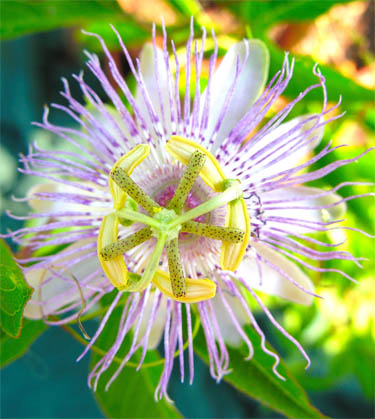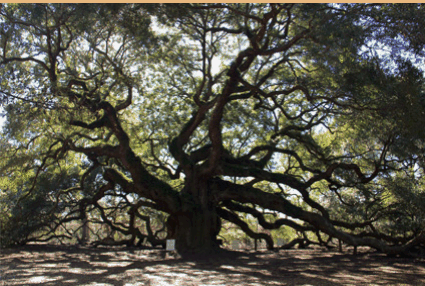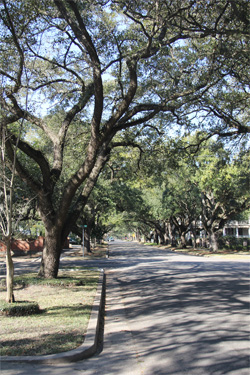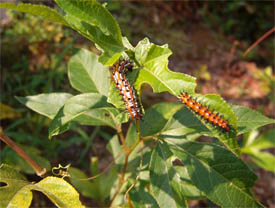















Magnolia Eden
Southern Live Oaks
Nature's Great Survivors
Nature's Great Survivors
Passiflora incarnata, or Passion Flower, is a most intriguing plant, worthy of a place in any southern garden where its beauty and function can be fully appreciated. Not particularly fussy and demanding, the plant tolerates a variety of soil conditions and can thrive in full sun and partial shade. Its elaborate, showy flowers falsely allude to more exotic origins, but this American native is widespread throughout the American South and elsewhere. As if its good looks are not enough, Passion Flower is also a host plant to the beautiful Gulf Fritillary butterfly, making it of particular interest to butterfly enthusiasts.
Utilized by Native Americans and grown by southern settlers, Passiflora incarnata was introduced in England in 1629 and first offered in an American nursery/seed catalogue in 1811 by the Philadelphia-based Landreth Nursery.
A vigorous grower, the perennial Passiflora climbs by tendrils, reaching 10-20 feet. It can also be grown as a ground cover. Blooming between May and September, Passion Flower produces edible oval fruits old-timers often refer to as maypops. Many a southern kitchen has turned out jars of maypop jelly, and some commercial fruit juices available today contain extract from maypops.
While seeds can be retained from the fruits of Passiflora, it is easily propagated by rooting cuttings.
What's in a name?
Named by Roman Catholic missionaries, according to legend, Passiflora is perhaps best known for its Christian symbolism. Hardly referencing eroticism or sexuality, Passion Flower and its various parts represent Christ's crucifixion. There are ten petals for the ten apostles present at the crucifixion, an ovary column resembling a cross, three stigmas for the nails, colored filaments for the crown of thorns, five pollen-bearing anthers for Christ's wounds and coiling vine tendrils reminiscent of whips or scourges.
A Gracious Southern Host
Passiflora incarnata is especially admired by butterfly lovers because it is a host plant to the Gulf Fritillary (Agraulis vanillae). Planted in sufficient quantity along with butterfly-attracting plants like Echinacea, Buddleja and Lantana, Southern gardeners are almost guaranteed to witness nature at work as Gulf Fritillaries are drawn to the garden to lay their eggs on the various parts of Passiflora. The resulting spiny larvae feed ravenously on the leaves before pupating and emerging as a new generation of butterflies. With a wingspan of nearly three inches, the Gulf Fritillary is neither a true fritillary nor a heliconian, but rather is classified as a longwing butterfly. Ranging from New Jersey and Iowa to South America, Gulf Fritillaries are very common throughout the American South.
Where is your passion?
Passion Flower can still be found growing on old homesteads, and seeds and cuttings for rooting are often available free for the asking. Seeds are also available commercially and via heirloom seed exchanges. As catalogues begin arriving in the mail later this fall and winter, be sure to add Passiflora incarnata to your seed order. Neither you nor the butterflies will be disappointed!
Utilized by Native Americans and grown by southern settlers, Passiflora incarnata was introduced in England in 1629 and first offered in an American nursery/seed catalogue in 1811 by the Philadelphia-based Landreth Nursery.
A vigorous grower, the perennial Passiflora climbs by tendrils, reaching 10-20 feet. It can also be grown as a ground cover. Blooming between May and September, Passion Flower produces edible oval fruits old-timers often refer to as maypops. Many a southern kitchen has turned out jars of maypop jelly, and some commercial fruit juices available today contain extract from maypops.
While seeds can be retained from the fruits of Passiflora, it is easily propagated by rooting cuttings.
What's in a name?
Named by Roman Catholic missionaries, according to legend, Passiflora is perhaps best known for its Christian symbolism. Hardly referencing eroticism or sexuality, Passion Flower and its various parts represent Christ's crucifixion. There are ten petals for the ten apostles present at the crucifixion, an ovary column resembling a cross, three stigmas for the nails, colored filaments for the crown of thorns, five pollen-bearing anthers for Christ's wounds and coiling vine tendrils reminiscent of whips or scourges.
A Gracious Southern Host
Passiflora incarnata is especially admired by butterfly lovers because it is a host plant to the Gulf Fritillary (Agraulis vanillae). Planted in sufficient quantity along with butterfly-attracting plants like Echinacea, Buddleja and Lantana, Southern gardeners are almost guaranteed to witness nature at work as Gulf Fritillaries are drawn to the garden to lay their eggs on the various parts of Passiflora. The resulting spiny larvae feed ravenously on the leaves before pupating and emerging as a new generation of butterflies. With a wingspan of nearly three inches, the Gulf Fritillary is neither a true fritillary nor a heliconian, but rather is classified as a longwing butterfly. Ranging from New Jersey and Iowa to South America, Gulf Fritillaries are very common throughout the American South.
Where is your passion?
Passion Flower can still be found growing on old homesteads, and seeds and cuttings for rooting are often available free for the asking. Seeds are also available commercially and via heirloom seed exchanges. As catalogues begin arriving in the mail later this fall and winter, be sure to add Passiflora incarnata to your seed order. Neither you nor the butterflies will be disappointed!
By Dr. Ed Brotak
"Only God can make a tree." according to Joyce Kilmer in his famous poem, Trees. One look at a southern live oak, and you know God made these trees to last. With massive trunks and huge branches, these rugged trees are built to withstand whatever nature throws at them. And how long do they live? Hundreds of years or more!
"Only God can make a tree." according to Joyce Kilmer in his famous poem, Trees. One look at a southern live oak, and you know God made these trees to last. With massive trunks and huge branches, these rugged trees are built to withstand whatever nature throws at them. And how long do they live? Hundreds of years or more!


Perhaps the best example of longevity is the Angel Oak on Johns Island just outside of Charleston. It is estimated to be over 1500 years old! To live this long, a tree has to able to "take a beating." This was the case in September 1989. Near midnight on the 21st, Hurricane Hugo, a Category 4 hurricane with winds over 135 mph and a storm surge of 20 feet, crashed ashore just north of Charleston. The Angel Oak was severely damaged, as you would imagine, but with a little help from its human friends it has since recovered.
Ed Harshaw
This intricate Passiflora incarnata bloom was photographed on June 27, 2006 in the garden of Southern Edition editor Greg Freeman by Lowcountry photographer Ed Harshaw. Harshaw's work was featured in the story, Ed Harshaw: Capturing the Splendor of the Lowcountry One Photo at a Time.
The Angel Oak, Johns Island, South Carolina
We find southern live oaks (Quercus virginiana) from the coastal regions of southern Virginia, down along the Atlantic coast, throughout all of Florida, and then extending along the Gulf coast into central Texas. The live oak, a member of the white oak family, likes a warm, moist environment. Although below freezing temperatures can occur in winter, the extreme cold of more inland locations is missing. The tough, leathery leaves of the live oak can withstand the occasional bouts of freezing temperatures. The name "live oak" comes from the fact that these trees always have green leaves on them even through the winter. Old leaves do die off once a year, but only after new leaves have emerged to replace them.

The southern live oak is an impressive tree. Its massive trunk can be more than 20 feet around. Trees can range in height from 40 to over 100 feet, but its spread is what makes it noteworthy. Branches of the crown can reach out to 100 feet and more. Often the branches are draped with Spanish moss, resurrection fern, or mistletoe.
Hurricanes are a constant threat along these coastal areas. And, with individual trees living for decades or centuries, the odds are that the tree must at some point withstand winds that can exceed 100 mph. Defenses start with a deep tap root and an extensive root system surrounding it. This anchors the tree and helps prevent uprooting in the strong winds. As mentioned before, huge trunks and large branches made of extremely hard wood lessen the risk of the branches or trunk breaking. Strong onshore winds bring salt spray which can kill the leaves of many hardwood trees. The leaves of the live oak are resistant to the salt. Coastal flooding with saltwater is also a threat with major hurricanes. But the live oak roots can tolerate an occasional saltwater intrusion.
Drought conditions can bring wildfires, just another threat live oaks must deal with. Live oaks are actually very susceptible to fire damage with their low hanging branches. But the dense shade produced by the tree's canopy makes the ground around the tree pretty much free of dense vegetation that could ignite and spread the fire to the crown of the tree. Even if the tree is damaged by fire, with its root system intact, it will send up numerous new sprouts.
Hurricanes are a constant threat along these coastal areas. And, with individual trees living for decades or centuries, the odds are that the tree must at some point withstand winds that can exceed 100 mph. Defenses start with a deep tap root and an extensive root system surrounding it. This anchors the tree and helps prevent uprooting in the strong winds. As mentioned before, huge trunks and large branches made of extremely hard wood lessen the risk of the branches or trunk breaking. Strong onshore winds bring salt spray which can kill the leaves of many hardwood trees. The leaves of the live oak are resistant to the salt. Coastal flooding with saltwater is also a threat with major hurricanes. But the live oak roots can tolerate an occasional saltwater intrusion.
Drought conditions can bring wildfires, just another threat live oaks must deal with. Live oaks are actually very susceptible to fire damage with their low hanging branches. But the dense shade produced by the tree's canopy makes the ground around the tree pretty much free of dense vegetation that could ignite and spread the fire to the crown of the tree. Even if the tree is damaged by fire, with its root system intact, it will send up numerous new sprouts.

Ed Harshaw


A Gulf Fritillary butterfly paying a visit to Lantana 'Miss Huff'

Live oak-lined residential street, Georgetown, South Carolina
Back in the day of the sailing ships, live oaks were prized by shipbuilders. The wood was heavy and very hard. Naturally curved trunk and branches could be cut to provide solid pieces in various shapes. The USS Constitution was built in 1794 using live oak wood from St. Simons Island, Georgia. The name "Old Ironsides" was a testament to the strength of the live oak and its ability to withstand enemy shellings. Our fledgling navy was so enamored by these trees that the first government tree farm was established in 1829 on Gulf Breeze, a barrier island off of Pensacola. The Naval Live Oaks Reserve is open to the public there today, and still has a remnant population of live oaks.
A number of live oaks are record holders. The Airlie Oak in Wilmington, North Carolina is the largest tree (in diameter) in the state. This giant, estimated to be 500 years old, has a trunk over 21 feet around which extends upward to 128 feet, and has a crown spread of 104 feet. Another 500-year-old tree is the South Carolina Champion Oak in Georgetown. This state champion is 23 feet around, 120 feet tall, and has a canopy spread of 125 feet. The Seven Sisters Oak, the largest certified southern live oak in the country, can be found in Lewisburg, Louisiana near Mandeville. Estimated to be 1500 years old, this giant has a trunk 38 feet around and a crown spread of 139 feet. Carole Doby, who used to own the tree, was one of seven sisters. This tree survived Hurricane Katrina.
A number of live oaks are record holders. The Airlie Oak in Wilmington, North Carolina is the largest tree (in diameter) in the state. This giant, estimated to be 500 years old, has a trunk over 21 feet around which extends upward to 128 feet, and has a crown spread of 104 feet. Another 500-year-old tree is the South Carolina Champion Oak in Georgetown. This state champion is 23 feet around, 120 feet tall, and has a canopy spread of 125 feet. The Seven Sisters Oak, the largest certified southern live oak in the country, can be found in Lewisburg, Louisiana near Mandeville. Estimated to be 1500 years old, this giant has a trunk 38 feet around and a crown spread of 139 feet. Carole Doby, who used to own the tree, was one of seven sisters. This tree survived Hurricane Katrina.
Larvae of the Gulf Fritillary butterfly feeding on the leaves of Passiflora incarnata
Living as long as they do, live oaks have become landmarks in many of the cities and towns of the South. Some have even become part of folklore. The Duffie Oak in Mobile, at an estimated 300 years, is the oldest living landmark in the city. The Emancipation Oak in Hampton, Virginia was on the campus of a learning center for newly freed slaves, and was where the Emancipation Proclamation was first read to them. On the dark side, the Dueling Oaks were in a New Orleans city park which was the regular site for sword fights back in the 1800s. Only one tree is now left standing. Back in Mobile, we also have the Boyington Oak. Charles Boyington, who was convicted of murder and hanged, said a large oak would grow out of his heart to prove his innocence.
Want to have your own living landmark? Southern live oaks can be grown in a variety of soils. They grow quickly when young and require little attention other than occasional watering when it gets dry. Soon you will have a distinctive tree that provides shade and will attract a variety of birds and animals that forage on the acorns produced. And who knows? Maybe your tree will become a piece of history.

SOURCES
100 Oaks Project: A photodocumentary of the 100 oldest live oaks in the South
www.100oaks.wordpress.com
Louisiana Garden Club Federation, Inc.
www.lgcfinc.org/live-oak-society.html
United States Department of Agriculture Natural Resources Conservation Service: Plants Database
http://plants.usda.gov/core/profile?symbol=QUVI
100 Oaks Project: A photodocumentary of the 100 oldest live oaks in the South
www.100oaks.wordpress.com
Louisiana Garden Club Federation, Inc.
www.lgcfinc.org/live-oak-society.html
United States Department of Agriculture Natural Resources Conservation Service: Plants Database
http://plants.usda.gov/core/profile?symbol=QUVI
Author: Dr. Ed Brotak. Published April 27, 2014.
Copyright
Southern Edition
All Rights Reserved
Southern Edition
All Rights Reserved
All materials contained on this site, including text and images, are protected by copyright laws and may not be reproduced without prior written permission from the publisher. Where applicable, use of some items contained on this site may require permission from other copyright owners.
Fair Use of text from SouthernEdition.com is permitted to the extent allowed by copyright law. Proper citation is requested. Please use this guide when citing a Southern Edition article.
Contact Greg Freeman or SouthernEdition.comFair Use of text from SouthernEdition.com is permitted to the extent allowed by copyright law. Proper citation is requested. Please use this guide when citing a Southern Edition article.